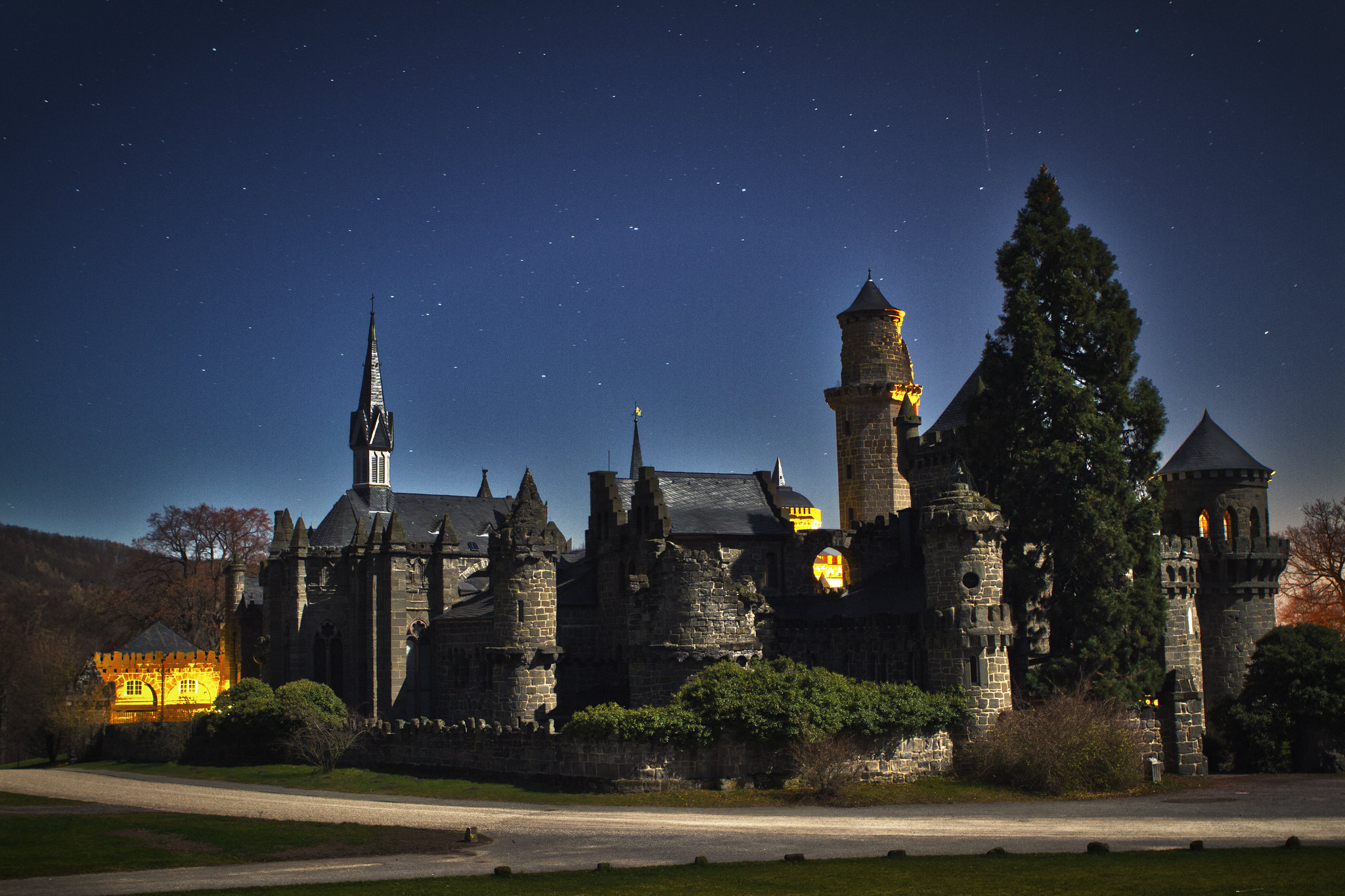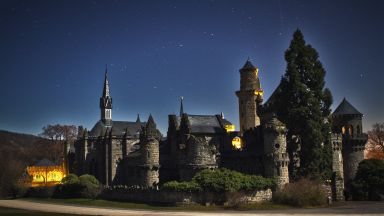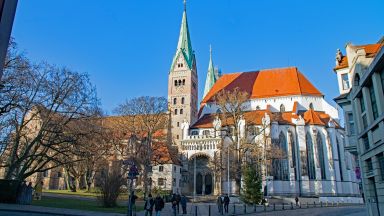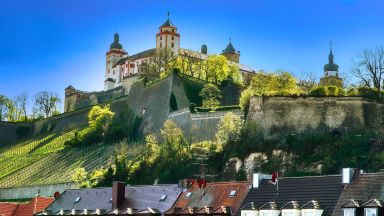Exploring Germany's Fairy Tale Route
This website uses affiliate links which earn a small commission at no additional cost to you.
The German Fairy Tale Route (Deutsche Märchenstraße) is a well-known driving route spanning 600km through Germany from Hanau to Bremen. Visitors are taken on a journey to the locations made famous by the Brothers Grimm in their beloved collection of fairy tales. From Snow White’s cottage shared with the seven dwarfs, to Rapunzel’s tower balcony, and the town of Hamelin where the Pied Piper once played his tune, the route runs from north to south, starting in Bremen and ending in Hanau, the brothers’ birthplace in central Germany. However, we opted to travel in reverse, exploring the route as we headed south from England, discovering unexpected gems along the way.
- What is the German Fairy Tale Route?
- Suggested Itinerary of the German Fairy Tale Route
- Day 1 Hanau to Alsfeld
- Day 2: Marburg to Kassel
- Day 3: Kassel to Göttingen
- Day 4: Göttingen to Hameln
- Day 5: Hameln to Bremen
- Highlights of the German Fairy Tale Road
- Hanau
- Gelnhausen
- Steinau an der Straße
- Alsfeld
- Marburg
- Bad Wildungen
- Hessisch Lichtenau
- Kassel
- Hannoversch Münden
- Hofgeismar
- Trendelburg & Rapunzel's Castle
- Göttingen
- Fürstenberg
- Hameln
- Bodenwerder
- Bad Oeynhausen
- Bremen
What is the German Fairy Tale Route?
Established in 1975, the German Fairy Tale Road, or Deutsche Märchenstraße, is a national tourist route spanning 370 miles / 600km. It was created to boost tourism and links over 30 towns and communities between the Main river and the North Sea.
The route begins in the Hesse town of Hanau in central Germany and ends in the Free Hanseatic City of Bremen in the north. The main attractions along the way are focused on the Brothers Grimm, particularly locations where they lived and worked throughout their lives, as well as regions, towns, and cities related to the collection of fairy tales they wrote in 1812. This collection, known today as Grimm’s Fairy Tales, was added to the UNESCO World Heritage Document List in 2005.
The Verein Deutsche Märchenstraße society, located in the city of Kassel, manages the route, which is marked by road signs featuring a stylized heart-shaped body and head of a princess wearing a crown.
Suggested Itinerary of the German Fairy Tale Route
Day 1 Hanau to Alsfeld
On the first day of your trip embark on a road trip from Hanau the birthplace of the Brothers Grimm, Steinau an der Straße to see the childhood home of the Brothers Grimm and on to Alsfeld for the Fairy Tale House.
There are additional towns you can visit which are on the route: Gelnhausen, where you can see a ruined Imperial Palace, Schlüchtern, Freiensteinau, Grebenhain, Herbstein and Lauterbach.
German Fairy Tale Route Day 1 Hanau to Alsfeld Route on Google maps.
Day 2: Marburg to Kassel
Your second day brings you from Marburg, Bad Wildungen a possible inspiration for Snow White to Kassel and its Grimm World museum.
There are additional towns you can visit which are on the route: Neukirchen, Willingshausen, Lahntal, Rauschenberg, Frankenberg-eder, Waldeck, Wolfhagen, Niedenstein, Schauenburg and Baunatal.
German Fairy Tale Route Day 2: Marburg to Kassel Route
Day 3: Kassel to Göttingen
On the third day of the official fairy tale road trip the route splits in two, between the Sleeping Beauty Route or the Mother Hulda Route.
We choose to stay mainly on the sleeping beauty route and double back on ourselves to visit Göttingen.
The route leads you through Hannoversch Münden, Reinhardswald Forest (including Sababurg Castle, known as the Sleeping Beauty Castle), Hofgeismar and Trendelburg (Rapunzel’s Castle) and Göttingen.
German Fairy Tale Route – Day 3: Kassel to Göttingen Route
Day 4: Göttingen to Hameln
Day 4 takes you through Trendelburg and Hameln, where you can spot fairy tale references to Rapunzel and the Pied Piper.
German Fairy Tale Route – Day 4: Göttingen to Hameln Route
Day 5: Hameln to Bremen
Your last day leads you through Bad Oeynhausen before concluding your journey in Bremen, where the Town Musicians of Bremen will greet you with open paws.
German Fairy Tale Route – Hameln to Bremen
Highlights of the German Fairy Tale Road
Hanau

The official starting point our trip along the Fairy Tale Route, is at Hanau, 30km away from Frankfurt. The town holds a special significance as it was where the Grimm brothers spent the early years of their life until they were five and six years old.
Upon arriving in Hanau, your first stop should be the Marketplatz, the town square where you can see a bronze statue of the Brothers Grimm, built in 1896. The statue sits in front of Hanau Rathaus, or town hall. If you’re there on a Wednesday or Saturday, you can also check out the local markets in the square. While the architecture around the square is mostly modern and not very exciting, a short seven-minute walk north will take you to the stunning red and white medieval Deutsches Goldschmiedehausent or Goldsmiths’ House, which once served as the town hall. Unfortunately, it is one of the few remaining structures in the Altstadt (old town) to have survived WWII bombings.
The Grimms Märchen Reich, which opened in 2019, is a must-visit. This hands-on museum located in Schloss Philippsruhe takes young visitors on a magical tour through seven interactive fairy tale worlds. The exhibits include a collection of clothes, documents and other artefacts that once belonged to the brothers.
After that, head to the beautiful Wilhelmsbad Park where the castle ruins may look dilapidated but hide a princely residence where time has stood still. Here, you can also find the Hessisches Puppenmuseum or Hessian Doll and Toy Museum, which presents world history in miniature scale.
Additionally, Hanau is also the home of the annual summer Brothers Grimm Festival, which features live performances of the fairy tales, including musicals and family plays.
Read our Hanau Travel GuideGelnhausen

Gelnhausen has a rich history that dates back to the 12th century, and it is known for its well-preserved medieval architecture, including the town hall, market square, and the Church of Saint Peter and Paul. – In the 12th century, Emperor Friedrich Barbarossa built a castle on an island near this quaint town.
Read our Gelnhausen Travel GuideSteinau an der Straße

Steinau an der Straße is where the Brothers Grimm lived until they were 12 and 13 years old. You can visit The Museum Brüder Grimm-Haus Steinau, located in the brothers’ childhood home on Brüder-Grimm-Straße and offers visitors a glimpse into the daily lives of the Grimm family. The Fairytale Fountain or Märchenbrunnen is located in the centre of the marketplace and depicts many scenes from Grimm’s Fairy Tales, making it a popular spot for photo opportunities. The Castle Steinau was built in the 12th century and served as the home of the counts of Hanau-Steinau. Visitors can explore the castle’s history and see exhibits related to the Brothers Grimm.
Read our Steinau an der Straße Travel GuideAlsfeld

Dating back to 1069, Alsfeld has a connection to the famous fairy tale of Little Red Riding Hood, in which a young girl is tricked by a wolf disguised as her grandmother. The Brothers Grimm drew inspiration from the traditional headscarf worn by the Schwalmland women in this region for Little Red Riding Hood’s cape.
With more than 400 half-timbered houses and buildings, Alsfeld’s Market Square is home to the Town Hall, Weinhaus and other historic structures. For more fairy tale references, visitors can explore the Alsfeld Fairy Tale House, The Little Red Riding Hood statue and the Regional Museum Alsfeld.
Read our Alsfeld Travel GuideMarburg

The small, vibrant university town of Marburg, is located approximately 40 minutes away from Alsfeld, offers visitors a variety of attractions to explore. One of the most well-known is the Marburg Castle, which was originally built in the 11th century as a fort. Situated on a hilltop, the castle provides stunning views of the surrounding area and now functions as a museum.
Another must-visit location is the magnificent St. Elizabeth’s Church, constructed in honour of Saint Elizabeth of Hungary, also known as St. Elizabeth of Thuringia. She is the patron saint of bakers, nursing homes, brides, and beggars, and her tomb is located within the church.
For those who enjoy botanical gardens, the scenic Marburg Botanical Gardens are just a 10 minute drive from the church and offer a lovely place to take a relaxing stroll.
Read our Marburg Travel GuideBad Wildungen

Bad Wildungen is a classic spa town that boasts an iconic attraction – Friedrichstein Palace. Originally built as a castle, this impressive structure has been converted into a museum, and is said to have inspired the Brothers Grimm’s famous fairy tale, Snow White.
In the 16th century, Count Philipp IV and his daughter Margaretha von Waldeck resided in the castle. Tragically, Margaretha died at a young age, believed to have been poisoned, much like the character of Snow White. Interestingly, Margaretha’s brother founded the nearby mining village of Bergfreiheit, which is said to have inspired the workplace of the Seven Dwarfs in the story, and is located in the heart of the Kellerwald Forest.
Read our Bad Wildungen Travel GuideHessisch Lichtenau

Located just 50 minutes away from Bad Wildungen, Hessisch Lichtenau is a charming town renowned for its magnificent architecture and half-timber framed houses. The town center is adorned with beautiful landmarks, including the 17th century town hall, which serves as the home to the Frau Holle Museum.
At the museum, visitors can explore the fascinating world of Frau Holle, also known as Mother Hulda, and discover her four distinct realms: the fairytale world, the physical world, the underworld, and the herbal world. With so much to learn and discover, a visit to the Frau Holle Museum is a must for anyone visiting Hessisch Lichtenau.
Mother Hulda is a popular figure in yet another well-known fairy tale that depicts the story of her beautiful and diligent stepdaughter and her lazy and unattractive biological daughter, whom Mother Hulda favors more.
In the tale, the stepdaughter accidentally drops her spindle down a well and jumps in to retrieve it. She finds herself in a fantasy world where she helps others and is rewarded with a golden appearance. Meanwhile, Mother Hulda’s biological daughter also jumps into the well, but she refuses to help anyone and returns covered in tar that never washes off.
The moral of the story is clear: hard work always pays off, and laziness is never rewarded. This timeless lesson is just one of the many enduring messages conveyed through the beloved tales of the Brothers Grimm.
Read our Hessisch Lichtenau Travel GuideKassel

Traveling north, be sure to spend the remainder of your day in Kassel, widely regarded as the heart of the Fairy Tale Route. The Brothers Grimm lived and worked in Kassel for more than three decades, they spent their youth as librarians here for the King of Westphalia – Jerome Bonaparte, who was also the youngest brother of Napoléon.
It was during their tenure as librarians for the King of Westphalia, Jermaine Bonaparte (Napoleon Bonaparte’s younger brother), that the brothers compiled most of their fairy tales and folklore stories. Jacob Grimm even wrote in 1860 that “the Kassel years were the happiest of our lives,” a sentiment that is still evident today in this beautiful city.
Just outside the city centre lies the Bergpark Wilhelmshöhe, a UNESCO World Cultural and Natural Heritage site that encompasses approximately 560 hectares of Europe’s largest hillside park. The park is home to Löwenburg Castle, Schloss Wilhelmshöhe, and a magnificent 19th-century tropical glasshouse, making it a perfect destination for a day trip from Kassel.
Reaching the summit of the Bergpark Wilhelmshöhe, you will find the impressive Hercules monument, featuring a copper statue of the mythological hero. Although the climb up the 520 steps may be strenuous, the stunning view from the top makes it all worthwhile. And for a refreshing break, there’s a café waiting for you!
Read our Kassel Travel GuideHannoversch Münden

Hannoversch Münden is a charming town located on the Fairy Tale Route in Germany. The town is known for its well-preserved medieval architecture, including over 700 half-timbered houses, which make it one of the most picturesque towns on the route.
In the Middle Ages, Hannoversch Münden was an important trading town, with its location at the confluence of the Werra and Fulda rivers making it an important transportation hub. Today, visitors can explore the town’s rich history through its numerous museums, including the Hann. Münden Museum, which is housed in a former prison, and the German Half-Timbered House Museum, which showcases the town’s architectural heritage.
One of the town’s most famous landmarks is the historic town hall, which dates back to the 14th century and features a distinctive clock tower. Visitors can climb the tower for panoramic views of the town and the surrounding countryside.
You can also visit Bursfelde Abbey (in German Kloster Bursfelde) is a former Benedictine monastery located in the hamlet of Bursfelde.
Read our Hannoversch Münden Travel GuideHofgeismar

Hofgeismar is a small town known for its historic half-timbered buildings and charming medieval atmosphere. One of the main attractions in Hofgeismar is the 650 years old Castle Sababurg, which is located just outside the town. This castle is said to have been the inspiration for the castle in the story of Sleeping Beauty, and visitors can tour the castle’s interior, which includes a museum and a restaurant. This 600-year-old castle is surrounded by an impenetrable hedge of thorns, added in the late 1500s to act as a corral for horses and cattle. In 1765, the castle was turned into a hunting lodge, which the Brothers Grimm frequently visited.
A live fairy tale performance can be experienced at the former open-air knight’s hall of Sababurg Castle on Saturdays and Sundays at 2pm between April and October, where you can meet Sleeping Beauty and her prince.
Another popular destination in Hofgeismar is the Reinhardswald Forest, where visitors can take a walk through the woods and imagine themselves in a fairy tale. The forest is said to be the setting for many of the stories collected by the Brothers Grimm, including Little Red Riding Hood and Hansel and Gretel.
Read our Hofgeismar Travel GuideTrendelburg & Rapunzel's Castle

If you’re traveling from Göttingen to Trendelburg, take a detour to Adelebsen Castle if you’re a fan of history or architecture. This well-preserved medieval castle, converted into a palace, is located on a sandstone cliff above the Schwülme River, about 10 miles / 16km west of Göttingen.
In Trendelburg, the most popular attraction is Trendelburg Castle, also known as Rapunzel’s Castle. The castle dates back to the 13th century and features the tower that inspired the fairy tale of Rapunzel, the princess who let down her long hair from the window to allow her beloved to climb up. Today, the castle is home to the luxurious Hotel Burg Trendelburg and a restaurant. Tourists can still access the castle tower for panoramic views of the town, which is particularly beautiful at night when the lights are on and there are fewer visitors around.
If you’re looking for outdoor activities in Trendelburg, consider hiking through Urwald Sababurg or taking the Weser Skywalk and Hanoverian Cliffs route, which offers stunning landscape vistas and is slightly less demanding.
Read our Trendelburg Travel GuideGöttingen

Göttingen is a city with a strong connection to the Brothers Grimm, who taught as professors at the university there. Visitors can explore the university’s botanical gardens, established in 1736, and walk along the 250-year-old town walls that encircle the city center.
One of the city’s iconic landmarks is the Gänseliesel (Goose Girl), a fountain statue based on a Grimm fairy tale about a courtier who steals a princess at birth and raises her as a goose girl. Visitors can climb the fountain and kiss the statue, a tradition that dates back to 1901 and is especially popular among graduates of the University of Göttingen.
Other notable attractions in Göttingen include the town hall, which is located just behind the Gänseliesel statue, the Wiechert’sche Erdbebenwarte Science Museum and the impressive St. Jacobi Church.
Read our Göttingen Travel GuideFürstenberg

Fürstenberg is particularly associated with the tale of “The Frog Prince.” According to the story, a princess loses her golden ball in a well, and a frog offers to retrieve it in exchange for a promise from the princess to let him eat from her plate and sleep in her bed. The princess reluctantly agrees, but when the frog returns with the ball, she runs away instead of keeping her promise. Later, the frog appears at the princess’s castle and is revealed to be a handsome prince under a spell.
In Fürstenberg, visitors can see the well where the princess supposedly lost her golden ball and the nearby castle where the prince lived. The castle, known as Schloss Fürstenberg, was built in the 17th century and is now home to a porcelain museum.
Read our Fürstenberg Travel GuideHameln

Hameln, also known as Hamelin, is a town famous for the Pied Piper legend. According to the story, the Pied Piper led all the town’s rats to the river with his magic pipe, where they drowned. However, when the citizens refused to pay for the rat catcher’s services as promised, he retaliated by leading their children away with his instrument’s magical power. Bungelosenstrasse, or the “street without drums,” is believed to be the last place that the children were seen, and since then, music or dancing has been forbidden on this street.
Throughout the town, you can find references to the tale, such as two Pied Piper fountains, a stained-glass window in the Market Church, the Pied Piper’s House on Osterstraße Street, and a 26 x 42-foot Pied Piper Relief at the Buergergarten gate. Additionally, you can see many bronze rat-shaped stones around town that create a trail to pass by these notable tourist sites.
If you’re in Hameln during the summer months, you can also catch live fairy tale performances in the town square. Other attractions to visit include the wedding house next to the Nicolaikirche, the Bürgerhus on Kupferschmiedestraße, and several churches dating back to the 11th and 13th centuries, such as the Stiftsherrenhaus and Leisthaus with their ornate facades. If you’re looking for a quieter experience, head to the Alte Marktstraße and surrounding streets to see rows of beautifully preserved medieval buildings.
Read our Hamelin Travel GuideBodenwerder

Bodenwerder is located on the river Weser, about 11 miles south of Hameln, this 700-year-old town was once the home of the legendary Baron Karl Friedrich Hieronymus von Munchhausen. Known for his adventurous tall tales, this European aristocrat was made famous in the fantastical 1989 movie The Adventures of Baron Munchausen.
The Munchhausen Museum, housed in the manor where the baron was born in 1720, showcases historical artefacts. During summer Sundays at 3 pm, local actors can be seen to perform Munchhausen tales in front of the Rathaus. Moreover, there is an annual Lichterfest held on the second Sunday in August, where a stuntman dressed as Munchhausen is featured. He is towed over the town by a helicopter while sitting atop a cannonball.
Read our Bodenwerder Travel GuideBad Oeynhausen

Located approximately 45 minutes away from Hameln, you can visit the town of Bad Oeynhausen, which is home to the Fairy Tale and Weser Legends Museum, open from Wednesday to Sunday.
For nature enthusiasts, Bad Oeynhausen boasts two national parks, Kurpark and Sielpark, where you can enjoy a leisurely stroll. In addition, Aqua Magica Park is also available for visitors to explore, created to celebrate the healing properties of water.
Read our Bad Oeynhausen Travel GuideBremen

If you’re traveling from Bad Oeynhausen to Bremen, consider stopping in Hannover for a rest. This large and historic city has numerous attractions and activities to explore.
Bremen may be the smallest city in Germany by population, but it offers visitors an abundance of sites and things to do, potentially making it a full-day trip. The city’s highlight is the Town Musicians of Bremen, a famous tale about four mistreated domestic animals, including a donkey, dog, cat, and rooster, who decide to leave their former masters and become musicians in Bremen.
Although the animals never reach the town, as they scare off a group of robbers and take their treasure, they can be seen throughout the city in the form of statues, sculptures, and murals. These characters are a common sight, from adorned shops to painted walls.
The renowned bronze statue by Gerhard Marcks is the most well-known statue of the Town Musicians of Bremen, erected in 1953 at the corner of the Bremer Rathaus. This famous statue has replicas that can also be found in front of each of the five German veterinary schools and the Lynden Sculpture Garden in Milwaukee, Wisconsin.
Explore the Saint Petri Dom Bremen cathedral, built in the 11th century, and climb the bell tower to enjoy stunning panoramic views of the city. Take a leisurely walk through the Martplatz to admire the magnificent town hall. If you’re lucky enough to visit in October or December, you may get the chance to experience the exciting Freimarkt Fair or the charming Christmas market.
Read our Bremen Travel GuideThis website uses affiliate links which earn a small commission at no additional cost to you.



